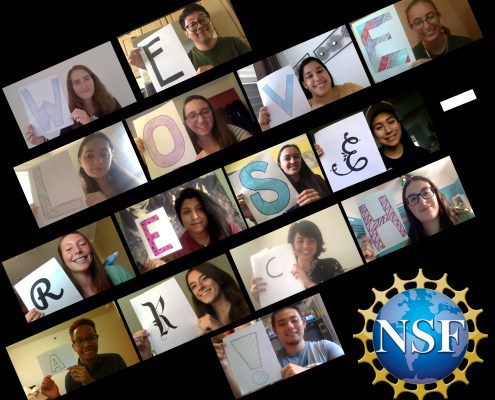Whether you are a researcher, research administrator, evaluator, or in a research development office, it is important to know how universities can effectively partner with entities outside of campus. In this post, we will discuss how to form partnerships for use in the broader impacts section of a National Science Foundation (NSF) proposal.
As mentioned in our first post in the Broadening Participation and Broader Impacts blog series, entitled “A History of Broader Impacts Criterion Within the National Science Foundation”, we detailed the creation of an explicit broader impacts criterion in the merit review process of NSF proposals.
Broader impacts – the potential to benefit society and contribute to the achievement of specific, desired societal outcomes – PAPPG, NSF 22-1
The inclusion of an explicit broader impacts criterion in the merit review process was to require proposers to address areas of societal concern within the context of the proposed activity. NSF defined broader impacts using five general subcategories: 1) integrating research and education, 2) broadening the participation of underrepresented groups, 3) enhancing the infrastructure for research and/or education, 4) disseminating project results broadly to enhance understanding of science and technology, and 5) describing potential benefits to society at large.
Beyond these five general subcategories, NSF suggests the following areas of impact:
- Full participation of women, persons with disabilities and underrepresented minorities in STEM
- Improved STEM education and educator development at any level
- Increased public scientific literacy and public engagement with science and technology.
- Improved well-being of individuals in society
- Development of diverse, globally competitive STEM workforce
- Increased partnerships between academia, industry, and others
- Improved national security
- Increased economic competitiveness of the United States
- Enhanced infrastructure for research and education.
The big challenge in developing broader impacts is balancing the desire to create innovative, impactful, and evidence-based activities with strong evaluation plans with the reality of small budgets, resources, and the lack of expertise and time.
The key to overcoming these challenges is forming partnerships with people and/or entities outside of the research team. Broader impacts are a team effort, and therefore it is essential to engage with partners from the start.
Why Partnerships?
If you are still struggling to see the importance of partnerships in broader impacts, consider their importance in business. Wharton Management professor Dr. Harbir Singh says this about partnerships, “By clearly identifying what you want to achieve through the partnership, and choosing the appropriate strategy, you can stretch your innovation dollars, share in the costs of investments, better handle uncertainty, and access new resources, capabilities, and markets.”
Effective broader impacts are:
- Achievable
- Substantive
- Assessable – especially for broadening participation
- Personal – a partnership you want to do
Partnership Defined
There are many definitions of partnerships, but in the context of broader impacts partnerships, the definition by Kingsly (2000) is the most appropriate.
“A form of inter-organizational relationship where the participants engage in reciprocal patterns of communication for the purposes of identifying shared vulnerabilities, developing shared goals and a shared understanding of how they will pursue and achieve these goals.”
No matter which definition of a partnership is used, there are three commonalities in all partnerships:
- Mutuality in exchange – rely on each other and both benefit from the partnership.
- Oftentimes the relationship between a University and K-12 schools do not have mutuality in exchange. Usually the K-12 schools are expected to get a benefit from the University, but the University doesn’t think carefully enough about the benefits that could accrue to them from the K-12 schools.
- Enhancement of the standalone identity of partner
- Many will enjoy being within a partnership and the people they work with, but they don’t necessarily think about how well do I, personally, benefit from this particular thing.
- Collaborative processes – there is a level of engagement that is a bit more than just a handshake contractual agreement.
The methods and modes of interactions within partnerships will change over their lifetime. With some changes occurring while the partnership matures or when various activities are completed.
There are three types of partnerships:

Strategic Partnerships
Partners are mutually dependent on each other in some way
- Reduce duplicative efforts for organizations, and/or their members
- Can function with limited trust and interaction
- Positioning to create a best-in-class advantage
Example: The Polar Literacy Initiative

Learning Partnerships
Organizations work well together but may not rely on one another to achieve their goals
- Gain new insights and knowledge from each other
- Co-produce new knowledge tools or opportunities
- Inspire each other or innovate together
- Partnership is built in service of the joint learning and development of essential skills.
Example: The Ocean Observatories Initiative (OOI) Data Labs Project

Transformational Partnerships
The gold standard of partnerships and seen throughout NSF solicitations. The partnership bolsters each organization’s possibility of realizing its vision.
- Re-imagine a system through advocacy, capacity building, and/or providing tools
- Energizing social innovations and generative growth
- Moral dimension – community engagement and equality
Some Tips for a Good Partnership
- Have a clear understanding for the motives for parties in the partnership
- Clarify the goals and objectives for the partnership (what we will do together – both at the individual and institutional level)
- Research and “know” your partners
- Make sure you manage the partnership (time and attention)
- Listen to each others needs and goals/objectives
- Build awareness and continuity of roles in the partnership
- Practice equitable and fair budgeting
- Keep the fun in the relationship
Metrics for successful partnerships
What are the impacts of the partnership? What is the ability of the partnership to produce results and add value? A program evaluation can help determine the success of a partnership by helping:
- Articulate tangible results for the partnership
- Develop clear metrics of success
- Strive for lasting or sustainable outcomes
- Determine how will you sustain/adopt elements (programs, strategies, etc.) from the partnership.
Write the broader impacts section with your partner
If your proposal is two weeks away and you have not already talked to your broader impacts partner(s) or engaged with them in other ways, then don’t put them in your proposal. A partnership that is rushed and formed out of a necessity to check a requirement by the funding agency is not genuine.
Additional Resources
The STEM Center at Colorado State University can help you develop your broader impacts activities and evaluate them. Schedule a consultation with the STEM Center to get started.
Advancing Research Impact in Society (ARIS), is an NSF-supported organization that elevates research impacts by providing high-quality resources and professional development opportunities for researchers, community partners, and engagement practitioners.ARIS has developed a Broader Impacts Toolkit with resources and tools designed to help researchers and broader impacts professionals develop projects and partnerships that will satisfy the broader impact requirements of NSF proposals.

Dr. Cheryl L. Bowker
Associate Director – STEM Center
Cheryl has worked at the STEM Center since 2013 and has evaluated and managed several STEM education projects. Cheryl enjoys impassioned discussions about research, education, and insects. Check out the Staff page for contact details.
Disclaimer: The thoughts, views, and opinions expressed in this post are those of the author and do not necessarily reflect the official policy or position of Colorado State University or the CSU STEM Center. The information contained in this post is provided as a public service with the understanding that Colorado State University makes no warranties, either expressed or implied, concerning the accuracy, completeness, reliability, or suitability of the information. Nor does Colorado State University warrant that the use of this information is free of any claims of copyright infringement. No endorsement of information, products, or resources mentioned in this post is intended, nor is criticism implied of products not mentioned. Outside links are provided for educational purposes, consistent with the CSU STEM Center mission. No warranty is made on the accuracy, objectivity or research base of the information in the links provided.
Get Notified of New Posts
Subscribe and receive email notifications about new posts directly in your inbox.



